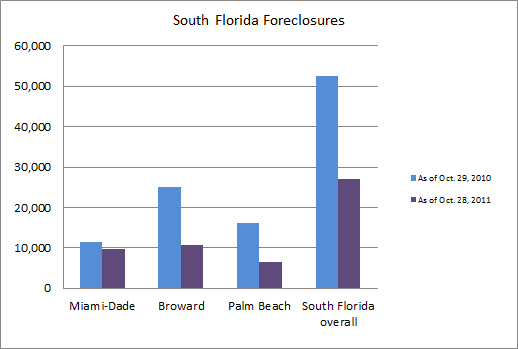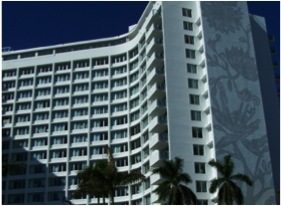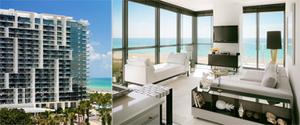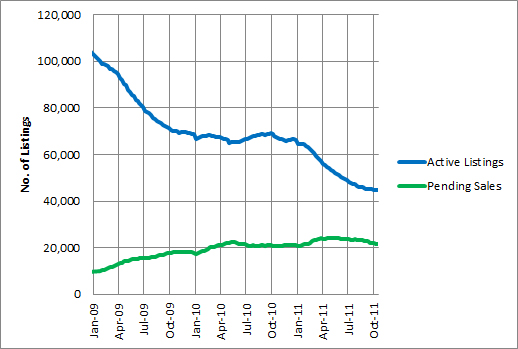Buying distressed real estate debt remains growth area
Local real estate companies are taking advantage of opportunities for buying distressed commercial real estate debt. But it’s a niche market for players with lots of cash and resources.
DISTRESSED DEBT BY PROPERTY TYPE
| Outstanding | Change | Worked | RR* | |
| Distress ($M) | vs 2010 | Out (%) | (%) | |
| Office | $41,857 | 8% | 50% | 68% |
| Apartment | 35,295 | -10% | 52% | 67% |
| Retail | 28,798 | 6% | 53% | 66% |
| Industrial | 11,541 | 1% | 36% | 73% |
| Hotel | 24,241 | -13% | 52% | 63% |
| Land | 25,863 | -9% | 33% | 54% |
| Other | 4,748 | 13% | 37% | 69% |
| All Props | 172,343 | -3% | 49% | 67% |
*Recovery Rate before costs and fees
BY ELAINE WALKER
EWALKER@MIAMIHERALD.COM
If there was an award for the most profitable single distressed commercial real estate debt purchase this year in South Florida, the Omni Center would win hands down.
Local real estate investors Jorge Perez, Jimmy Tate and Sergio Rok, looked at the struggling Omni Center and saw a great redevelopment opportunity in the midst of a revival along Miami’s Biscayne Boulevard. When they purchased the $161 million note in May that represented the bulk of the $206 million mortgage, their vision called for first gaining control of the property through foreclosure and eventually embarking on a mixed-use redevelopment plan. Selling wasn’t in the cards.
GENTING FACTOR
What they never expected was the Genting Group coming along four months later and buying them out at the full value of the note, with plans to incorporate the Omni as part of Resorts World Miami. The Perez-led group walked away with a $61 million profit in four months.
“We didn’t openly go out shopping that deal to sell it,” said Matt Allen, chief operating officer for Perez’s Related Group. “First and foremost we’re developers. The Omni site is one that we would have loved to develop. But it’s not a bad amount of money we made in four months.”
But before you think this is the new way to get rich quick, the Omni story is by far the exception rather than the norm. While purchasing distressed commercial real estate debt and distressed properties is gaining in popularity, those involved say it’s not a game for the inexperienced investor.
“Buying distressed debt is a very risky business,” said Ezra Katz, chief executive of Aztec Group, a Miami investment bank group that has also been purchasing debt. “A lot of people don’t understand the details. They smell a bargain and they take a risk. Unless you really know what you’re doing, stay out. If you want to gamble, you might as well go to Las Vegas.”
While most investors are purchasing debt as a way to gain control of a piece of real estate, it is no guarantee. The debt buyer could remain the lender. Gaining control of an asset requires foreclosure, which can be a costly and lengthy process, especially in South Florida.
Perez’s Related Group, as well as Tate and Rok, are among some of the bigger South Florida players in the distressed debt market. Other major players include Lennar’s Rialto Investments, LNR Property and RAM Realty Services of Palm Beach Gardens. Most are typically buying a mix of distressed debt, as well as distressed assets. Investments span all the asset classes from retail to multi-family apartments, office and hospitality.
The key is identifying quality assets that are underwater because they were overleveraged during the boom, rather than underlying flaws in the real estate.
Buying distressed debt and assets has been a key part of the Related Group’s strategy over the last few years. The company has purchased about 30 assets for close to $500 million, including undeveloped land in Hallandale Beach, Plantation and Fort Lauderdale, plus apartments in Myrtle Beach, S.C. Related has also teamed with Tate and Rok on retail properties in various markets from Arizona to Alabama.
EXPERTISE ESSENTIAL
“That’s how we’ve repositioned ourselves,” Allen said. “We have the expertise in all these aspects from development to asset management, that a lot of groups don’t have.”
Tate and Rok have purchased a total of nine deals valued at about $500 million, including properties in Coral Springs, New Orleans and Nashville.
“This is clearly a niche market,” Tate said. “The more transactions we close, the more experience we gain. We do not mind heavy lifting. The more heavy lifting that is involved, the more value we can create.”
While there are many institutional buyers, most of the bigger players in South Florida are larger real estate organizations with the ability and manpower to quickly evaluate the potential deals. Buyers must also have the cash to fund a deal. While it’s possible to refinance some of the debt later, closings tend to require quick turnarounds. Properties often need an additional capital infusion.
“To be competitive in this business, you’ve got to have ready capital available,” said Jim Stine, chief investment officer of Ram Realty Services. “Most of these properties need some work. The borrowers have probably been in default for a year or more. They’re not investing in the property and they’re not caring for them.”
Most recently, Ram closed last week on a $27 million note for a Plantation shopping center anchored by Publix and Steinmart. Over the past two and a half years, Ram has acquired 58 distressed real estate notes with a total debt value of approximately $275 million. For each property, the company paid between 20 percent and 80 percent of face value. Ram has recently formed its third investment fund that will target about $500 million of additional distressed note acquisitions, as well as other investments.
Stine and others in the industry see no signs of the deal flow slowing anytime soon.
At the end of the third quarter of 2010, approximately $3.2 trillion of outstanding debt was associated with commercial real estate, according to the Federal Reserve.
BOOM YEARS
Since most of the debt was financed during the boom years, the cycle could take as much as five to six more years to completely play out. There is an estimated $361 billion in commercial real estate debt expiring in 2012, and $1.4 trillion expiring between 2012 and 2015, based on a report from Deloitte, Foresight Analytics.
Real Capital Analytics estimates the outstanding commercial real estate distress currently at $172.4 billion, including $42.6 billion of properties already taken back by lenders. Real Capital estimates that puts workouts “nudging” the halfway mark.
“The market has really exploded since 2009,” said attorney Jon Chassen, chair of Bilzin Sumberg’s distressed property group. “It’s created its own industry.”
Miami Beach’s LNR Property is on the front lines of the deal flow, as the country’s largest special servicer of troubled commercial mortgages. Earlier this year LNR started a program with www.auction.com as a way to sell both distressed debt and properties.
“It’s a very efficient way for us to realize a market and value for properties,” said David Levin, vice chairman – investor relations for LNR, which is also purchasing debt. “An auction format shines a bright light on the process and the property. Anyone can bid. We’re getting more and better responses, everyone from Johnq@hotmail.com to Goldman Sachs. It’s very diverse.”
Transactions have increased as banks are more willing to mark their assets to market value, instead of continuing what the industry had dubbed the game of “extend and pretend.” That refers to what has been the tendency in recent years by lenders to extend the term of a loan to avoid writing down the value of the asset, which could have seen dramatic declines post recession.
Camilo Miguel Jr., chief executive of Mast Capital, a Miami Beach private equity firm that has partnered with the Related Group, said the number of debt purchases his company has made this year is more than double the last two years put together.
“We had been a little apprehensive about making acquisitions in the past as fundamentals were not supportive of the inflated pricing, but have started to dip our toe in,” Miguel said. “At this point in the cycle it’s starting to make more sense. Banks are selling some of the more desirable assets. We think that momentum is going to continue through the end of the year and next.”
Note buyers often pay 40 percent to 60 percent of the face value of the note, as banks are anxious to move the property and not deal with a potential foreclosure.
BRING VALUE BACK
“We prefer buying discounted notes because we fully understand this arena and how to bring value back to the collateral,” said Sergio Rok. “The banks take that loss and move on.”
But with all the available capital sitting on the sidelines, prices on certain assets are reaching levels that have left some buyers reticent to play the game of a bidding war.
The Adler Group has bid on about five different distressed debt purchases of office buildings and lost out. Instead, the company is focusing on buying undervalued distressed assets.
“We’re not just losing, we’re losing big,” said Matthew Adler, chief investment officer of Adler Group. “Because of the amount of equity that has been raised for this purpose it’s bidding up values that aren’t really supported by fundamentals. People are getting caught up in this frenzy.”
Global Fund Investments was formed in 2007 to buy distressed retail assets in the market, but it hasn’t worked out the way Doron Valero anticipated. He’s purchased four notes on retail shopping centers since that time, but he bid on at least 40.
“We thought it was going to be much easier to buy them,” Valero said. “I think everybody was caught by surprise that there weren’t more notes. You need to be focused on what you’re willing to pay and you need to walk when you need to walk.”
While Parmenter Realty Partners has always focused on distressed asset purchases of office buildings, Chairman Darryl Parmenter has never bought debt because he believes it’s “way over priced.”
One thing most players agree on is that the best deals haven’t been as plentiful or attractive in South Florida, as elsewhere. Many of the local investors have been spending the bulk of their capital elsewhere, making purchases around the state and throughout the Southern United States. Yet, Deutsche Bank has bought more debt in South Florida, than anywhere except New York.
“The problem with South Florida is that it’s a market that too many people want to be in,” Tate said. “It’s a good market with a lot of sizzle.”









